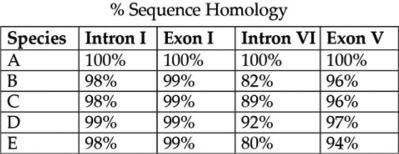The next question(s) refer to Table 20.1, which compares the % sequence homology of four different parts (two introns and two exons) of a gene that is found in five different eukaryotic species. Each part is numbered to indicate its distance from the promoter (for example, intron I is the one closest to the promoter) . The data reported for species A were obtained by comparing DNA from one member of species A to the DNA of another member of species A.  Table 20.1
Table 20.1
-Based on the tabular data, and assuming that time advances vertically, which cladogram (a type of phylogenetic tree) is the most likely depiction of the evolutionary relationships among these five species?
Definitions:
Hereditary Trait
A feature or characteristic passed from one generation to another through genes.
Reaction Range
Potential variability, depending on environmental conditions, in the expression of a hereditary trait.
Environmental Factors
External elements, including social, cultural, and physical conditions, that affect individuals' development and behavior.
Canalized Trait
A genetic term for a trait that is buffered against environmental variation and thus exhibits limited phenotypic variation across different environments.
Q5: <img src="https://d2lvgg3v3hfg70.cloudfront.net/TB6148/.jpg" alt=" Figure 19.3 Darwin
Q27: The process of translation in both prokaryotes
Q39: Which of the following types of mutations
Q40: The appearance of Pax-6 in all animals
Q41: What is occurring at time C that
Q43: Which group is noted for the independence
Q57: The importance of computers and of computer
Q63: Polytene chromosomes of Drosophila salivary glands each
Q79: Species D is pathogenic if it gains
Q85: Which of the following is a characteristic